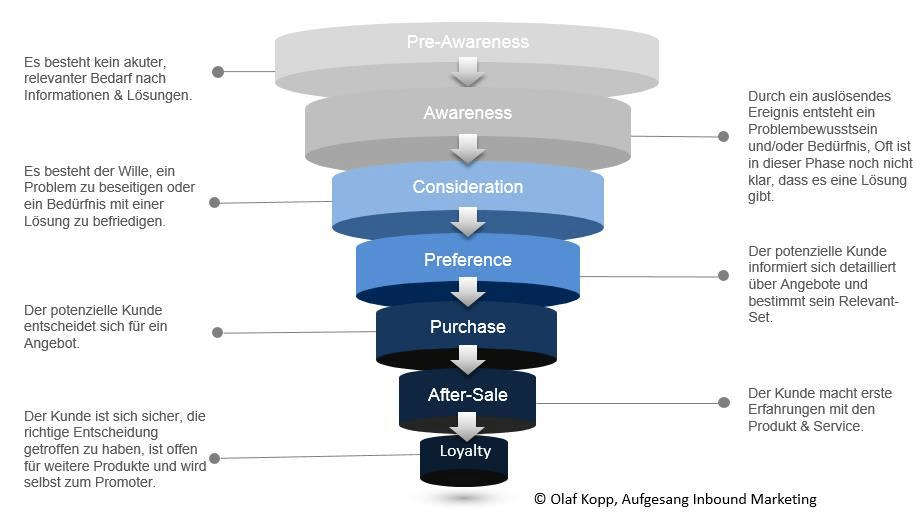What is a content strategy?
A content strategy is the basis for successful content marketing. Successful content marketing creates a competitive advantage over competitors. A content strategy is used to plan the creation and subsequent distribution of content. Strategic content planning is not only about creating good content, but also about long-term planning of which content can be best distributed via which channels.
A user-centered and systematic content strategy
It makes sense to consider a user-centered and systematic content strategy, as it not only costs less than traditional marketing measures, but also generates a large number of leads in the best case scenario.
A systematic content strategy generates attention and interest among your target group.
What is a lead?
A lead is contact with a potential customer who is interested in the company, service or product. Leads can be generated through personal contact - for example at trade fairs or networking events. They are generated through outbound methods such as email marketing or phone calls, or through content marketing.
Outbound methods are now subject to strict regulations and are therefore rarely suitable as the sole marketing strategy. People also often feel annoyed by outbound marketing.
Developing marketing strategies
Content marketing is often equated with inbound marketing. With successful inbound marketing, you establish yourself as a trustworthy company on the market through good content over the long term. A content strategy is developed to efficiently acquire and retain customers.
Content marketing is primarily about creating an audience and thus generating awareness. You could say that content marketing is the precursor to inbound marketing, which focuses on lead generation. However, content marketing also has an economic background in the long term, so the boundaries are often blurred here.
What both strategies have in common is that they do not want to impose themselves on the strategies of the target group. Relevant and helpful content generates attention and interest, which is distributed via blogs, search engines and social media, for example.
How relevant is content for the company?
Especially if you don't yet have an established customer base, you need to draw attention to yourself and good content is therefore essential.
Good content is the prerequisite for building a digital image - because in very few cases do you have the chance to communicate personally with potential customers right from the start. Relevant content sets you apart from the competition.
In contrast to traditional advertising, content marketing does not generate advertising pressure; instead, customers can decide for themselves who they trust and whose content they follow.
Effective content marketing
Effective content marketing only takes place if good content is produced in the long term.
In order to establish yourself on the market, you not only have to produce the content you create, but also market it well - both of which take the form of strategic measures.
How do I develop a content strategy for my company?
It doesn't matter whether you are just starting out with content marketing or want to revise your existing strategies: a well-thought-out content strategy is essential. Regardless of which area you are active in - almost everyone is now doing content marketing and the competition is pretty fierce.
A content strategy helps you to organize all the content you create - whether in the form of text, images or videos - and, above all, to be aware of who you are actually producing the content for.
What exactly is important?
If you want to plan and manage your content in the best possible way, you should consider the following 3 key aspects and ask yourself a few questions:
Pay attention to the tonality:
- Who am I creating content for?
- Who is my target audience?
- Which approach should I choose=
The form of the content:
- How do I want to appear?
- What do I stand for?
- What form of content suits my corporate image?
Keep an overview of the frequency:
- What form of content do I focus on?
- What content can I deliver in the long term?
- How often do I need to create new content in order to remain interesting for my target group in the long term?
5 steps to developing a good content strategy
In most cases, the following 5 steps are defined in current literature and are intended to help develop a good content strategy.
1 Content audit
The first step is to analyze the status quo of your previously published content so that optimization potential can be uncovered. After the analysis, it will become clear which content is superfluous, which content is missing and what could be relevant for the target group.
2 Target definition
As with any good strategy, the goals must be defined at the beginning. You are always working towards something - the extent to which the goals can be implemented in the process only becomes clear at a later stage. So before you create content, you should define what your intentions are.
3 Planning
Goals can only be achieved in the long term with precise content planning. Goals can change during the process and strategic measures usually have to be adapted and expanded. Nevertheless, a time frame should first be set by defining which goals can/should be achieved at which point in time. This also makes it easier to define what the content should look like in concrete terms and what content can be implemented.
In order to implement the content strategy, working with an editorial plan is extremely helpful. The editorial plan defines which content is to be published in which communication spaces. The editorial plan also specifies who in the team will develop the content.
If the company has no capacity to create the content itself (no in-house editorial team or too little time), it should be outsourced. This means that companies pass on the planning and creation of content to external contractors or service providers.
4 Creation and publication
When creating content, you must always ensure that you offer the reader/viewer added value. For example, you should ask yourself whether the text is entertaining or informative. Furthermore, whether the texts are easy to read, whether they are well structured for readers and search engines and whether they are well placed on the website.
For example, when content is created for platforms such as Instagram, it is always important to get the right message across. Images are "consumed quickly", so not much can be explained. The image must generate attention straight away, so it is particularly important that high-quality images are created.
5 Control
In content marketing, there are so-called KPIs (Key Performance Indicators) that can be used to measure success. The Content Marketing Institute (CMI) divides them into four areas:
- Metrics for lead generation
- Sales metrics (e.g. in the form of online sales)
- Consumption metrics (e.g. in the form of downloads)
- Sharing metrics (e.g. in the form of retweets)
When it comes to SEO and website traffic, this includes the following points, for example
- Length of time a visitor spends on a website
- Bounce rate (bounce rate)
- Page views of a website
- Social shares
- Newsletter subscriptions
If the desired goals are not achieved immediately, you should not give up straight away. If, for example, the declared goal is to rank higher on Google, this usually requires patience. Especially if the search engine ranking increases organically and the competition is fierce.
Create the right content
In order to create suitable content, it is necessary to define what the company stands for. The following questions must be asked:
- What makes the brand unique?
- What is the unique selling proposition (USP)?
- What added value can I offer?
Finding topics and research
Researching potential topics is extremely important throughout the entire process. It can be very helpful to analyze the competition.
- What topics are being discussed in the industry?
- Which channels are most popular?
- Can a content marketing strategy be identified?
Content strategies for websites
A well-functioning website generates leads. However, the main focus is still usually placed on the appearance of the website. Just because a website is beautifully designed does not mean it is suitable for marketing measures and sales. A well-functioning website is customizable and efficient.
Content strategies for websites are primarily there to make them easier to find online. If you use the right content, your Google ranking increases, more visitors come to the website and visitors stay on the site longer (dwell time).
There are also content strategies along the purchase process on the website, for example. This is known as the customer journey model. This type of content strategy on a website recognizes problems that a customer may have during the purchasing process and provides the appropriate information at all times.

The 7-step model of the Aufgesang agency group describes the customer journey very well.




